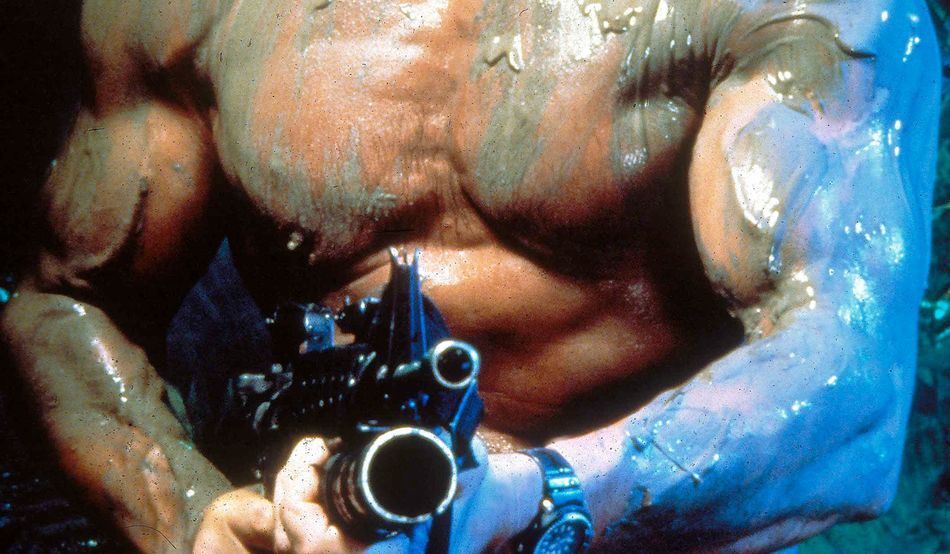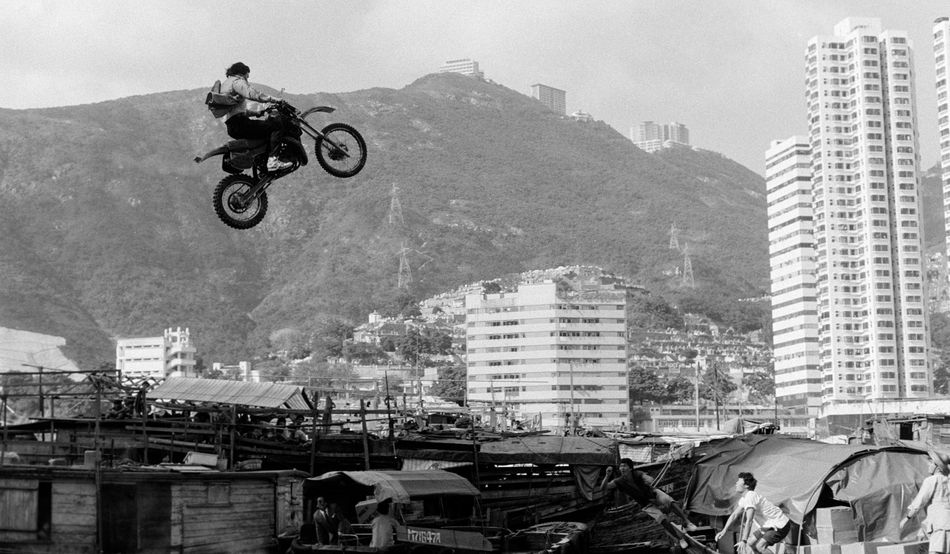My favourite sound in cinema is an untranscribable exhalation made only by Sylvester Stallone. He makes it when Rocky Balboa throws his most impactful punches; he makes it when Gabe Walker, the lead character in Cliffhanger (1993), clings precariously to a rock face; and he made it when, filming First Blood (1982), the original Rambo movie, he leapt from a cliff to a tree branch below and broke a rib in real life.
The noise is Stallone’s equivalent to the oft-quoted one-liners—“I’ll be back”; “Hasta la vista, baby”; “Yippee ki-yay, motherfucker”—that became catchphrases for his competitors in the action genre. Yet it is ironic that it is Stallone, the most literary of the supposedly meat-headed action stars—the one who was Oscar-nominated for Best Original Screenplay and who has wanted, his whole long career, to make a film about his hero, Edgar Allen Poe—who has had his on-screen essence boiled down to something beyond a one-liner, beyond even words, to a single distinctive sound.
Crucially, it is not a sound of triumph but one of struggle, because it is struggle—against the odds in Rocky (1976); against injustice in First Blood; against ageing in The Expendables (2010)—that defines Stallone’s movie persona. And that is why his movies appeal to me. I am severely disabled because of a combination of rare diseases and, the sicker that I become, the more I enjoy those absurd, overblown films made between the late 1970s and the early 1990s that are loosely defined as 1980s action movies.
I have a disabled friend who feels similarly. We often use a phrase inspired by Stallone: “Rambo repairs”. It references the extreme first aid, bordering on self-surgery, that John Rambo frequently performs on himself mid-battle. We use it to mean the DIY medical procedures—popping a dislocated joint back into place; treating fierce infections with whatever medications are to hand; strapping up an inexplicably disobedient body part—that disabled people routinely undertake while knowing that the need for them would scare an able-bodied person straight into A&E. Meanwhile, a famous line from Predator (1987)—“I ain’t got time to bleed!”—has become for us a catchphrase that we use when we are ignoring disturbing new symptoms because, if we reported them all to a doctor, it would mean that we never had time to do anything except report disturbing symptoms to doctors.
Nick de Semlyen is establishing himself as the leading chronicler of Hollywood in the 1980s. His first book, Wild and Crazy Guys, charted the careers, idiosyncrasies and cultural impact of the male comic actors and Saturday Night Live alumni—Steve Martin, Bill Murray, Eddie Murphy, John Belushi, Dan Ackroyd et al—who redefined American comedy films in the 1980s and 1990s. His second book, The Last Action Heroes, focuses on their action-movie equivalents, once characterised by Bart Simpson as “the Schwarzeneggers, the Stallones and, to a lesser extent, the Van Dammes.”
Besides Arnold Schwarzenegger, Sylvester Stallone and (to a lesser extent) Jean-Claude Van Damme, The Last Action Heroes profiles five other leading men—Bruce Willis, Dolph Lundgren, Chuck Norris, Jackie Chan and Steven Seagal—creating eight interwoven biographies that, taken together, form a patchwork portrait of an era when macho excess, on-screen and off, was at the heart of Hollywood’s most bankable genre.
De Semlyen has worked for Empire magazine for around 20 years and has amassed hours of interviews with most of the principal players in the biggest action movies of the 1980s. He draws heavily on these interviews and ones from other publications to give The Last Action Heroes elements of an oral history. The technique works well, with the stars’ boastful (Seagal, Van Damme) or modest (Chan, Norris) claims set against the reality researched by de Semlyen.
Even so, the book has a few factual errors. For example, page 20 twice states that Chuck Wepner, the journeyman New Jersey boxer who was the primary inspiration for Rocky Balboa, lasted through a full 15-round fight with Muhammad Ali, just as journeyman Philadelphia boxer Balboa lasts through a full 15-round fight with Apollo Creed. But although Wepner made it into the 15th round of his 1975 fight with Ali, and with just 19 seconds to go, he didn’t make it out. Before the final round was up, Ali unleashed a spiteful flurry of punches that sent Wepner careering first into the ropes and then onto the canvas. The referee ruled that Wepner could not continue and Ali won by technical knockout.
This detail is important, because Sylvester Stallone’s brilliance in writing Rocky was not in simply replicating the story of the Ali-Wepner fight but in reimagining it with the perfect movie ending. Stallone knew that his character couldn’t be decisively knocked out, as Wepner had been, and that he couldn’t miraculously win, as a loveable long shot in a lesser movie might do. Instead, he had to be still standing, out-pointed but unbowed, when the final bell rang. It is this ending, perfectly pitched between Hollywood fantasy and downbeat realism, that gave Rocky the power to enchant audiences to the extent that it won the Academy Award for Best Picture and, as de Semlyen demonstrates, began the 1980s boom for action movies.
Reading The Last Action Heroes I realised that, for me, the real-life equivalent of the ever-resilient Rocky Balboa is not Chuck Wepner but Jackie Chan. There are, fundamentally, two ways to become disabled through injury. The first is to suffer a sudden accident that results in the loss of a limb, say, or some form of paralysis. The other is over time, through the cumulative or combined effect of multiple injuries. Jackie Chan appeals to me because he constantly seems to be in danger of both. Chan—whose skills as an acrobat and martial artist make him a legitimate successor to Bruce Lee, and whose skills as a physical comedian make him a legitimate successor to Buster Keaton—is an action hero in ways that other stars, American stars, are not.
When Schwarzenegger or Willis shoot an action sequence, any danger is managed and minimised and the actors are insured. As an audience we know that, if a character played by Schwarzenegger or Willis jumps from the top of a tall clocktower to the street below, the scene has been shot to make it appear that the character has performed this feat while the actor portraying him has not.
But when a character played by Chan jumps from the top of a tall clocktower to the street below, as Sergeant Dragon Ma Yue Lung does in 1983’s Project A, we know that Jackie Chan has performed the stunt himself (and we might know, too, that, because of his commitment to working this way, Chan and his stunt team often operate uninsured). We are well aware that one of the world’s biggest film stars hasn’t died on set during a stunt, but, watching him fall, we see the many ways in which he might have. That provides an excitement that we cannot get from the stunts in Die Hard (1988) or Terminator 2: Judgment Day (1991).
Chan’s stunt work has long been described as “death-defying”—and it is—but it also defies disability. Any one of a hundred stunts Chan has performed in films could have caused a catastrophic injury that would have left him unable to walk. For me, watching in my wheelchair, this thrills me in a way I find cathartic (even though I wonder what a psychiatrist or disability studies professor would make of my response—and what it reveals about my attitude towards my own disabilities). Chan also captivates me because he is an action movie star—not just an action movie character—who, like many disabled people, repeatedly suffers through physical torment in the course of an ordinary workday and just keeps working. When filming, Chan often undergoes Rambo repairs because, on shoots where budgets are tight and time is limited, he ain’t got time to bleed.
De Semlyen’s descriptions of the clocktower stunt in Project A, and of other spectacular feats that Chan has suffered through, are frequently as alarming and electrifying as the stunts themselves. And this is a key reason why The Last Action Heroes is such a success: it discusses movies that are fun and fast-moving in prose that is fun and fast-moving too. Which is not to say that the author takes his subject lightly. De Semlyen is Empire’s editor-in-chief and it is heartening that a major figure in British film journalism treats these movies as worthy of his sustained attention. When they were first released, they were often disregarded by prominent critics.
‘The most famous British film critic of the era was Barry Norman, who bemoaned the state of an industry that had allowed Schwarzenegger to become its biggest star and dismissed him as “not so much an actor as a human special effect”. The most famous television critic in Britain at the time, Clive James, summed up Arnie by saying that he looked “like a brown condom full of walnuts.”
But it is the same characteristics that made Norman and James turn away from Schwarzenegger that draw me to him. At the height of the 1980s action movie, Schwarzenegger looked to have (and, given that he was a seven-time Mr Olympia, perhaps actually did have) the perfect human body. And the characters he played could perform feats—and withstand assaults—that only a perfect human body could endure. As the owner and operator of a human body so imperfect it can seldom withstand the assault of a trip to the supermarket, imagining myself in Schwarzenegger’s place on-screen provides exquisite escapism.
Though he may be more special effect than actor, Schwarzenegger is, at least, a physical special effect. There is a level of reality to 1980s action movies that is increasingly absent from modern ones. Films that focus on real bodies, and use stuntmen and practical effects, speak to the disabled person’s experience of navigating hazardous physical environments in a way that films made with green screens, computer-generated imagery or—some day soon, God forbid—artificial intelligence cannot.
De Semlyen identifies Last Action Hero, the 1993 Schwarzenegger film that gives his book its title, as the end of the era of the 1980s action movie. He makes a convincing argument: contrast the embarrassing commercial failure of Last Action Hero, with the success of Jurassic Park. The latter was released at the same time and used new graphics and animatronics that looked years ahead of the explosions and car crashes that typified 1980s action movies, announcing the evolution of the genre.
But, for all it did to kill the kind of action movie that I love most, Last Action Hero gave me a scene I think about more than any action sequence. The plot of the film sees Jack Slater—an amalgam of every action hero Schwarzenegger had played—leaping from a cinema screen and into the real world in pursuit of a murderous villain who has done the same. Although Slater ultimately defeats the bad guy, he is mortally wounded and the only option is to drag him back through the screen he burst out of because, in a movie universe like that, a little thing like a bullet through a major organ is scarcely a flesh wound.
I often imagine myself in the same situation. When I lose the ability to do another basic physical task I’d previously been able to do; or I suffer complications from the transplant surgery I have already had; or I plan for the transplant surgery I still need, I wish I could be transported into an 1980s action movie, where even my broken body could be fixed with a few Rambo repairs.
















